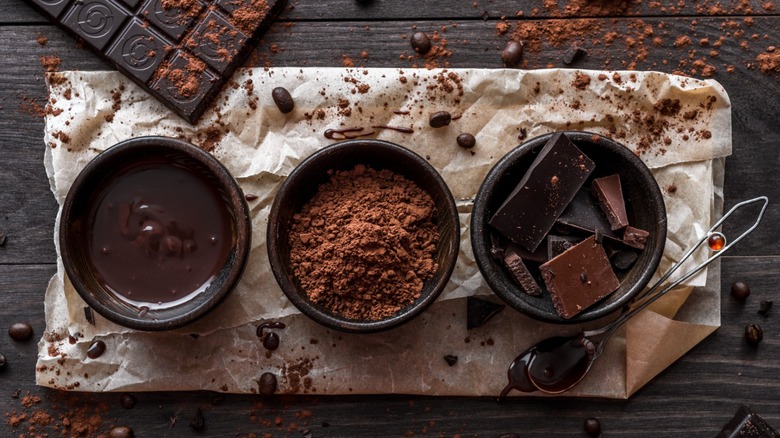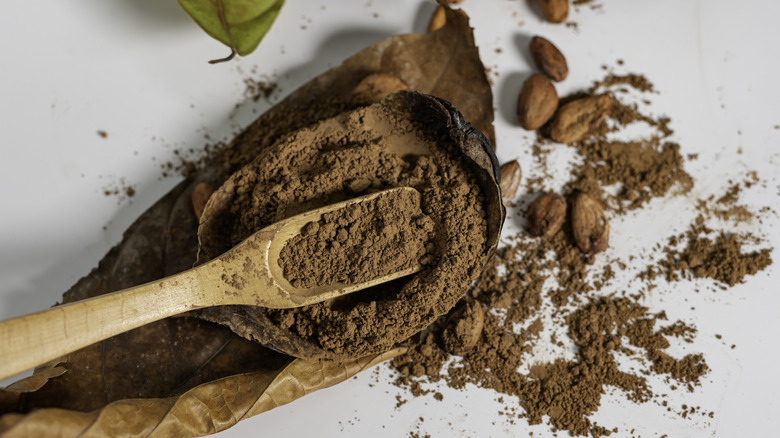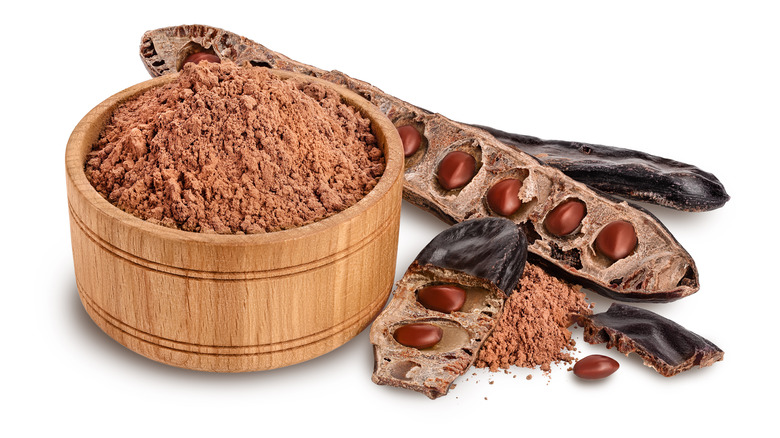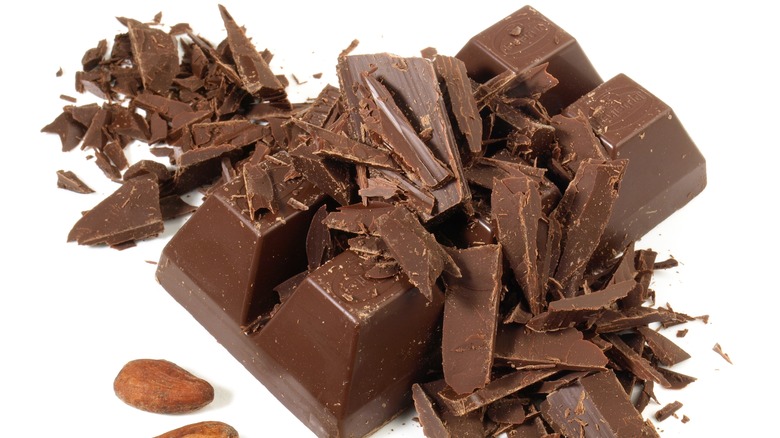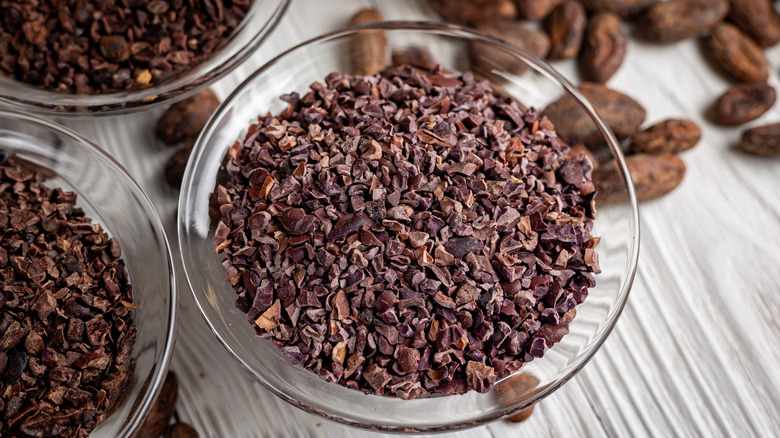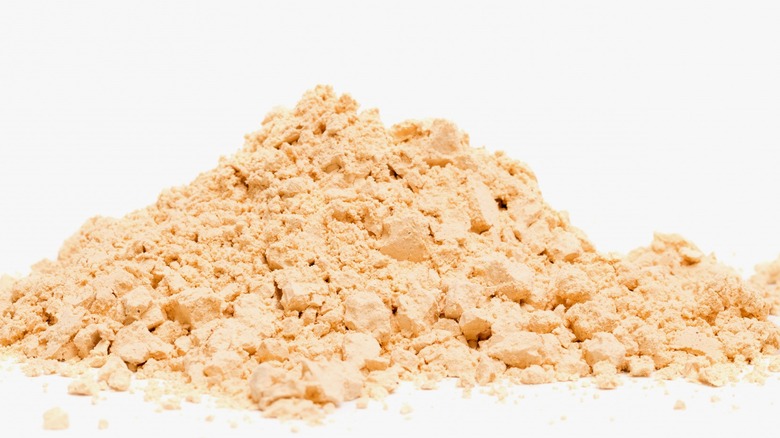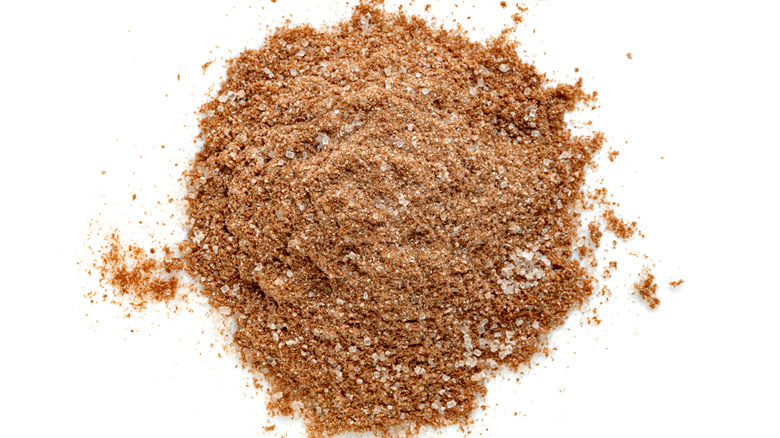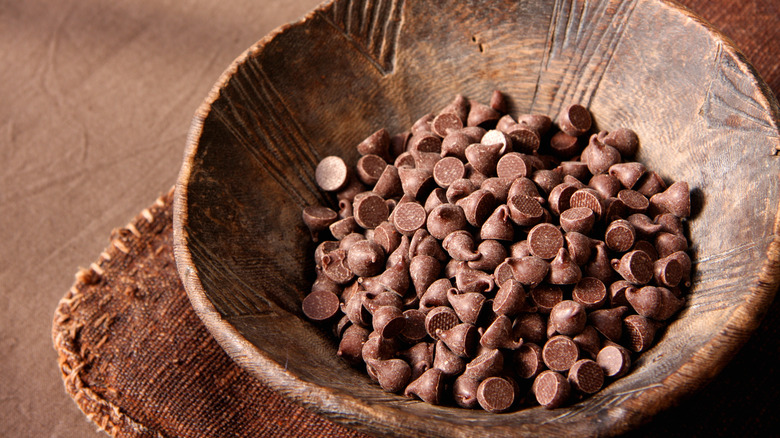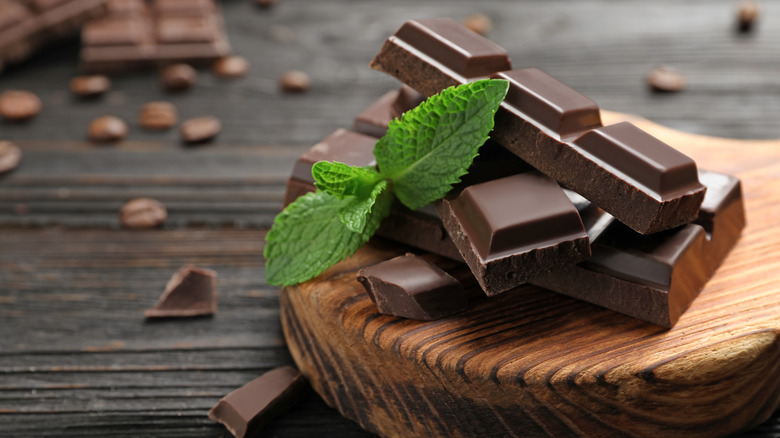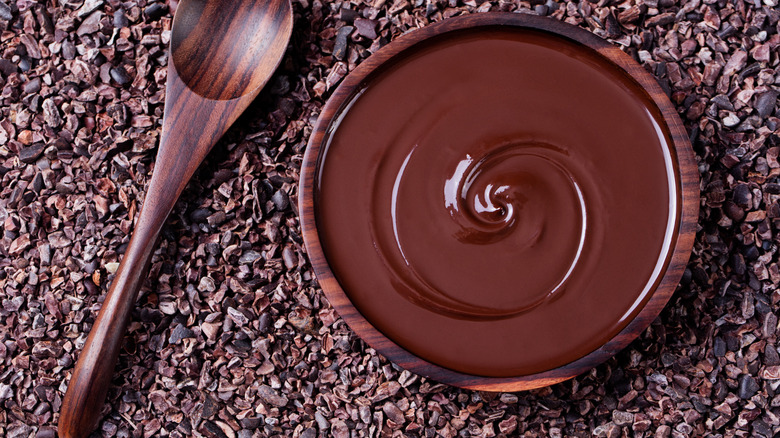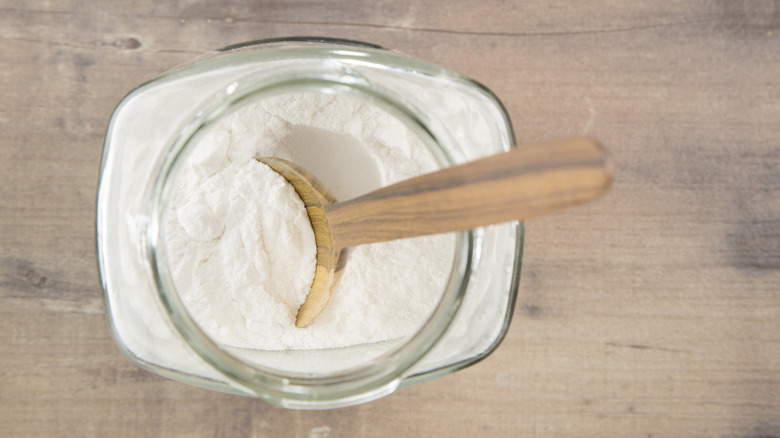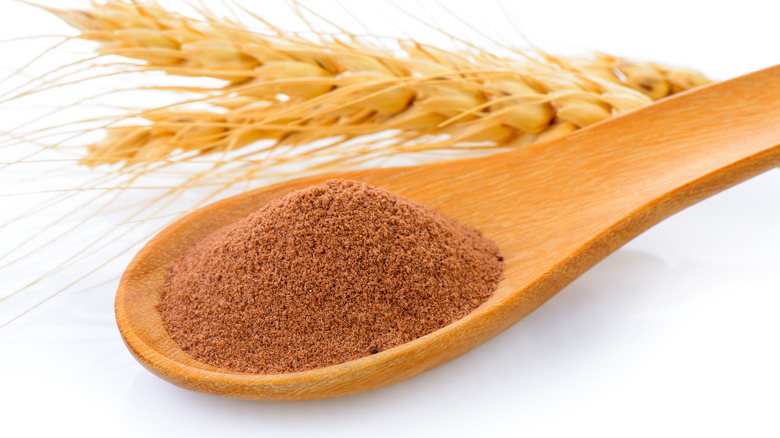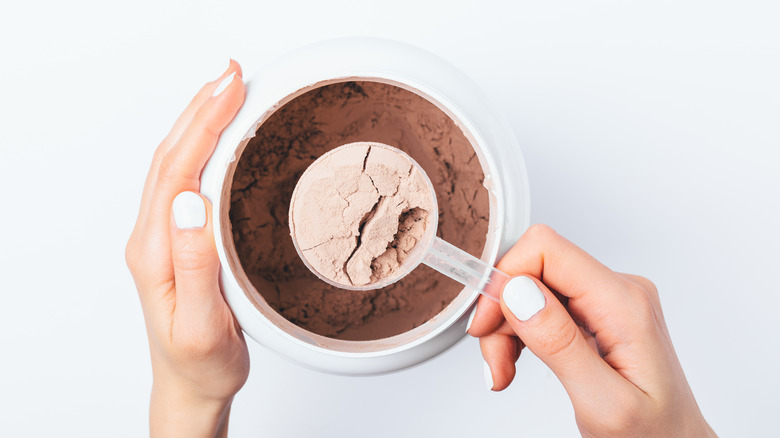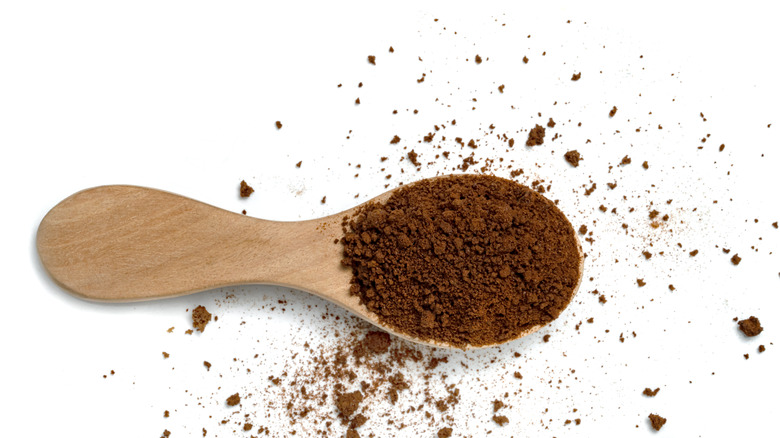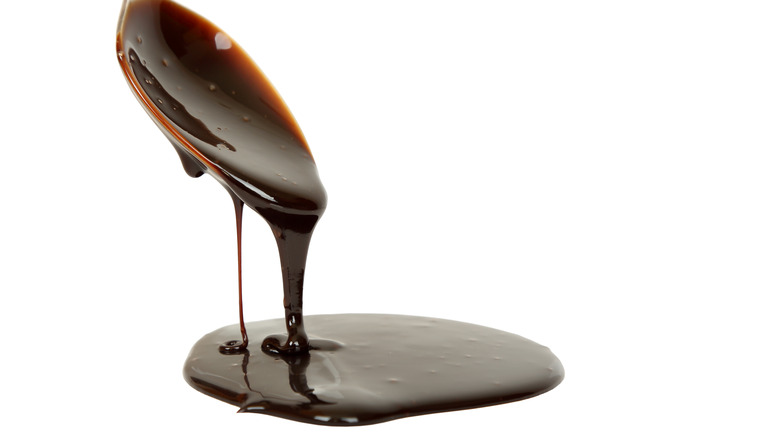14 Substitutes For Cocoa Powder You Should Know About
Don't let it spoil your day if you realize you're out of cocoa powder while making a recipe. Although it might appear that cocoa powder is challenging to replace, several alternatives are available, and some are probably in your refrigerator or pantry. First, there are different types of cocoa powder, such as black cocoa or Dutch process cocoa. Then, there is natural cocoa powder, which is the most popular one that you find in the average grocery store.
If your recipe doesn't specify which type, then natural cocoa powder is likely the one you need because it's the go-to product for simple baking and cooking. When natural cocoa powder is out of the picture, so is some of the acidity in the recipe. Therefore, you either need to include another acidic component, like buttermilk or vinegar, or simply change the leavening agent from baking soda to a better-fitting option.
Meanwhile, you don't need to worry about the acidity if you are replacing Dutch process or black cocoa since they usually work with baking powder instead of soda. These replacements may not be identical to cocoa powder, but they help you to successfully continue your cooking project when you are in a bind. With these options, you have the ability to weigh the pros and cons of each substitute and determine which is most suitable for your specific dish.
1. Raw cacao powder
If you're wondering what the difference between cacao and cocoa is, cacao powder is essentially the less processed version. Companies process cacao powder beans at much lower temperatures than the beans they roast for cocoa powder, which is how the term "raw" comes into play. Once cacao powder is made from the beans, its flavor is more bitter than its counterpart. It also has higher levels of antioxidants and minerals, such as magnesium and selenium.
You can use this powder with a 1:1 ratio for recipes when replacing cocoa powder. However, in some instances, when you bake it into foods, it can have a funky taste afterward. So, try to use it in recipes that aren't chocolate-forward but have other primary flavors. Or, stick to recipes that don't require baking, such as no-bake cheesecakes or other foods with sweet components that can help balance the bitterness. Aside from that, it doesn't alter the dessert's color or texture, which makes it an easy and beneficial swap.
2. Carob powder
Carob powder isn't a chocolate product, though it acts as a substitute for cocoa powder without the need to modify the ratio in your recipe. To create this powder, manufacturers dry and roast carob pods, which they then pulverize until it has a similar feel to cocoa powder. Nevertheless, it is sweeter than cocoa powder, so you can decrease the sugar in your recipe if you don't want the sweetness to be overpowering.
When you use this product, it doesn't give your recipe a chocolaty flavor. Instead, it has earthy and nutty notes reminiscent of vanilla or caramel, so the lack of chocolate isn't a big deal. As a matter of fact, many people use it as a natural sweetener for both foods and drinks because of its pleasant taste. Depending on the brand, its color can range from light to dark brown. Ultimately, you can utilize carob powder in any recipe. It works in various foods, ranging from smoothies to banana bread to pudding.
3. Couverture chocolate
This chocolate product often comes in blocks or chips, so it isn't a powder you can just measure and throw into your recipe. Yet, that doesn't mean it's not a worthy swap. Dark couverture chocolate has rich notes similar to cocoa powder since it's not super milky or sweet. It has a high fat content due to the cocoa butter it contains (which cocoa powder has much less of). If you compare the two, couverture chocolate consists of a minimum of 31% cocoa butter. Meanwhile, cocoa powder usually only holds 10-15% cocoa butter.
Consequently, when you use this as a fill-in, it's best to adjust your baking recipe to account for the added fat. For instance, if your recipe requires butter or oil, you can start using less of it and examine the food to see if it needs more. When you work with this substitute, melt it until it is smooth. If you use it in a delicate recipe with many eggs, allow the chocolate to cool slightly and then temper it to avoid curdling the eggs. For best results, use 25% less couverture than you would cocoa powder, and beware that the final product won't have an identical texture. This choice is appropriate for things like mousse, muffins, and double chocolate cookies.
4. Cacao nibs
People often use cacao nibs in milkshakes, overnight oats, or salads. But what exactly are cacao nibs? They are tiny crushed bits of cacao beans with a bitter taste and a nice crunch. Since cocoa powder is essentially ground-up nibs, — you can transform cacao nibs into homemade powder with the help of some kitchen gadgets. First, roast the nibs in the oven until they turn toasty, which gives them a deeper flavor. While there are different ways to turn them into dust, the best route is to use a two-step process. First, use the pulse setting on a food processor to break down the chunks.
Then, transfer the granules to a coffee grinder, transforming them into a fine powder. One downside to this cocoa powder substitute is that it takes time, effort, and equipment, which you might not have. Moreover, if your recipe calls for a large amount of cocoa powder, it might not be worth grinding multiple small batches of cacao nibs until you get as much powder as you need. On the other hand, if you only need a small amount, this is a top-tier option since it's a pure form of cocoa without any added sugar or fat.
5. Powdered peanut butter
If you're open to replacing the chocolate flavor in your recipe with a different one, powdered peanut butter can be your saving grace. It has a nutty yet sweet taste that works in sweet treats and smoothies with warm flavors and spices. Namely, it pairs with ingredients like chocolate curls, nutmeg, vanilla bean, cinnamon, and caramel. On the flip side, if your recipe contains a lot of citrus, the flavors might clash.
But if it's an appropriate option for your dish, it provides about three times the amount of protein per tablespoon compared to cocoa powder, which is an added benefit. This product has a similar texture to cocoa powder due to its fine consistency. Naturally, the color of peanut butter is much lighter than cocoa, so this replacement changes the looks of your recipe. This can be a bummer if your baked good relies on cocoa powder to give it a deep brown color, but for some folks, that isn't a dealbreaker.
6. Hot cocoa mix
Although hot chocolate mix isn't the easiest replacement, you can use it in a pinch in certain circumstances. For recipes that require multiple cups of cocoa powder, you are better off using something else. On the other hand, this works in small amounts where the chocolate isn't the central ingredient in the dish. Most hot cocoa blends contain sweeteners and added ingredients, which can make it tricky to use since it changes the consistency of the food. It doesn't mean it's a no-go, though. You just need to read the label and determine how much sugar the mix has.
A good practice is to add the hot cocoa mix to your recipe first and then determine if you need to add any sugar. Additionally, some hot cocoa packets are milk-chocolate flavored, which means they likely contain dried milk. This ingredient isn't too much to worry about, though; it just means that the final product has a creamy, candy-like taste rather than a bittersweet one. If you have a dark chocolate mix, it is undoubtedly the best kind to use since its flavor is closer to cocoa powder.
7. Chocolate chips
Chocolate chips are a pantry staple for many people, so they come in handy when you need a cocoa powder stand-in. Like the hot cocoa mix, dark chocolate or unsweetened chips replicate the cocoa powder flavor much better than the milk chocolate chips. When you use this alternative, it's crucial to look at the packaging because if the product has a lot of fat and sugar, you must reduce those ingredients in your recipe.
Aside from that, you don't need to worry if the flavor will be good or not (hint: it tastes fantastic). The appearance of the food or drinks turns out fairly similar to if you use cocoa powder, too. To use this substitute, melt the chips to a silky consistency and then incorporate it slowly. Use the melted chocolate to produce cookies, pies, and cakes. If you need to make frosting, it's entirely possible to make it with chocolate chips. But you might want to find a recipe designed to use them rather than adding them to a cocoa powder frosting recipe.
8. Dark chocolate bars
The high cacao content in a dark chocolate bar makes it a suitable alternative to cocoa powder. In fact, some baking recipes, like brownies, use melted dark chocolate instead of cocoa powder to begin with because it has a decadent flavor. With this substitute, you want as high of a cacao percentage as possible because it tastes closer to cocoa powder.
To incorporate it into your recipe, start with 25% less dark chocolate to get the texture and flavor right. So, if the recipe needs 1 cup of the powder, use ¾ cup of melted dark chocolate in its place. Unfortunately, one drawback to this choice is that you must break it up before you melt it. Otherwise, it doesn't heat evenly, and it might burn. Use a chef's knife to rough chop it into small chunks as a preventative, and you'll be fine. Also, it's wise to gradually mix it into the wet ingredients rather than throwing it in with the dry.
9. Chocolate liquor
First, chocolate liquor isn't what you think it is; it doesn't contain any alcohol, as its name might lead you to believe. It is simply a paste made from ground cacao beans and cocoa butter. Yep, that's right, it doesn't have any sugar, but a bold taste, and dark color, making it one of the best options on this list. The product comes in different forms, and the most familiar one to you is likely unsweetened baking chocolate, which is just the solid form of chocolate liquor.
However, you can also purchase semi-solid versions. The product also goes by other names, like cocoa mass, chocolate mass, or cocoa paste. When using it as a sub for cocoa powder, you need to melt it back to its liquid state anyway, so it doesn't matter what form you have. Start with a one-to-one ratio; if the taste isn't chocolaty enough, you can always add more to balance things out.
10. White chocolate powder
If you want to use a chocolaty powder, white chocolate-flavored powder is always available. Although, everyone knows white chocolate tastes entirely different than milk or dark chocolate. However, when you don't mind a slight change in flavor, it is a fantastic option since you don't have to spend time chopping or melting anything. And white chocolate pairs with all sorts of ingredients, such as raspberries, peppermint, strawberries, and assorted citrus fruits.
One thing to be aware of is how this powder acts as a sweetener and doesn't taste bitter. It is best when you want to make drinks such as flavored coffee, smoothies, or sweetened teas. But, depending on the brand, you can also use it in baked goods. For example, Ghiradelli's white chocolate powder can work in cookies, cakes, and other sweet treats. In the end, the white chocolate powder shouldn't make up most of the dry ingredient volume, but it can help when you want chocolaty undertones. As you can likely guess, it keeps your food and drink light-colored.
11. Malted milk powder
Like white chocolate powder, regular malted milk powder is a creamy color, meaning it doesn't give your food the same look that cocoa powder does. But there's another option: chocolate malted milk powder. Both of these powders contain malted barley, wheat flour, and powdered milk to create a pleasant, nutty flavor. Companies usually make the chocolate version with alkalized cocoa, which means it has less acidity than natural cocoa powder.
Whichever version you use, they're both pretty sugary, which is why people typically use this powder to upgrade their milkshakes. But you can also use it in other treats, like donuts or pancakes. As a fair warning, don't use them for recipes like chocolate cake, where you need a lot because it gives the dessert a pudding-like consistency, which might turn out more funky than enjoyable. Instead, stick to simple recipes requiring only a few tablespoons of cocoa powder.
12. Chocolate protein powder
If you have chocolate protein powder in your pantry, it can act as a makeshift cocoa powder substitute for certain recipes. Although it depends on the brand, some protein powders have an unpleasant aftertaste or are more artificial than others, so it's crucial to use a product that you like the taste of. If you plan to use it in a baking recipe, your best bet is a whey protein product since it comes from milk and works fairly well in baked goods. Nevertheless, with any type of protein powder, you run the chance of making the food dry or dense.
So, to combat this issue, add more eggs and liquid to your recipe, which loosens the batter and makes it moist. You can also run the powder through a sieve before you use it because it tends to get clumpy. It's not the best choice for complex recipes like souffles or macaroons where the slightest change in ingredients or measurements can destroy the whole dessert — think crepes, mug cakes, or muffins. And yes, it even works in frostings, too.
13. Espresso powder
Although baking espresso doesn't taste like chocolate, this alternative gives the recipe a rich, delicious flavor. It has bitter notes that taste well in foods with vanilla, sugar, maple, butterscotch, and more. Furthermore, espresso powder has a dark color similar to cocoa powder. Mix it into the wet ingredients so it can dissolve, which guarantees that it won't have a gritty texture.
This is an option you don't want to use a ton of since it is so intense and can overwhelm your palate when used in large amounts. Luckily, it is possible to compensate by mixing it with flour or another option from this list. You can always use this method in a recipe you've made before to determine if the batter's consistency looks normal or if you need to make any adjustments to it before cooking. On the other hand, it's a fantastic option when you just need a dash of something to kick up the flavor, like with gelato, pudding, shakes, and other no-bake recipes.
14. Chocolate syrup
You can use chocolate syrup when you want a replacement with a deep color and chocolaty taste. Bear in mind that the chocolate flavor is sweet and doesn't have the earthy undertones that cocoa powder has. Some chocolate syrups have higher amounts of cocoa than other brands, so how you approach this substitute depends on what the label says.
For example, Hershey's chocolate syrup contains cocoa powder, but its primary ingredient is high fructose corn syrup, and it also has sugar. In turn, you must reduce the sweetener in the recipe. Another thing to consider is that chocolate syrup is liquid. So, don't swap it using a one-to-one ratio because you might end up with a mixture that's too runny. Instead, omit a portion of the wet ingredients, such as water or milk, and make up for the remaining amount with the syrup. Taking these steps ensures that the food's taste and texture turn out just right.
